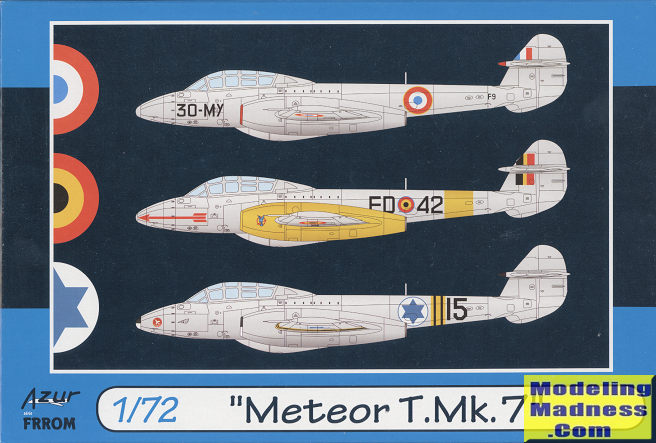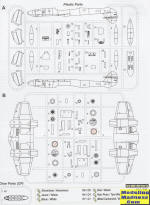
Azur/FRROM 1/72 Meteor T.7
| KIT #: | FR0045 |
| PRICE: | `$25.00 |
| DECALS: | Three options |
| REVIEWER: | Scott Van Aken |
| NOTES: | Reboxed MPM kit |

| HISTORY |
The Gloster Meteor was the first British jet fighter and the Allies' only jet aircraft to achieve combat operations during the Second World War. The Meteor's development was heavily reliant on its ground-breaking turbojet engines, pioneered by Frank Whittle and his company, Power Jets Ltd. Development of the aircraft began in 1940, although work on the engines had been under way since 1936. The Meteor first flew in 1943 and commenced operations on 27 July 1944 with No. 616 Squadron RAF. The Meteor was not a sophisticated aircraft in its aerodynamics, but proved to be a successful combat fighter. Gloster's 1946 civil Meteor F.4 demonstrator G-AIDC was the first civilian-registered jet aircraft in the world. Several major variants of the Meteor incorporated technological advances during the 1940s and 1950s. Thousands of Meteors were built to fly with the RAF and other air forces and remained in use for several decades.
The Meteor saw limited action in the Second World War in the ground attack role. Meteors of the Royal Australian Air Force (RAAF) fought in the Korean War. Several other operators such as Argentina, Egypt and Israel flew Meteors in later regional conflicts. Specialised variants of the Meteor were developed for use in photographic aerial reconnaissance and as night fighters.
The Meteor was also used for research and development purposes and to break several aviation records. On 7 November 1945, the first official airspeed record by a jet aircraft was set by a Meteor F.3 at 606 miles per hour (975 km/h). In 1946, this record was broken when a Meteor F.4 reached a speed of 616 miles per hour (991 km/h). Other performance-related records were broken in categories including flight time endurance, rate of climb, and speed. On 20 September 1945, a heavily modified Meteor I, powered by two Rolls-Royce Trent turbine engines driving propellers, became the first turboprop aircraft to fly. On 10 February 1954, a specially adapted Meteor F.8, the "Meteor Prone Pilot", which placed the pilot into a prone position to counteract inertial forces, took its first flight.
In the 1950s, the Meteor became increasingly obsolete as more nations introduced jet fighters, many of these newcomers having adopted a swept wing instead of the Meteor's conventional straight wing; in RAF service, the Meteor was replaced by newer types such as the Hawker Hunter and Gloster Javelin. As of 2018, two Meteors, G-JSMA and G-JWMA, remain in active service with the Martin-Baker company as ejection seat testbeds. One further aircraft in the UK remains airworthy, as does another in Australia.
The Meteor T.7 was a two-seat trainer variant of the F.4. The company prototype first flew 19 March 1948. Eventually, 640 production aircraft for the Royal Air Force and the Royal Navy (43) and 72 for export (Australia, Belgium, Brazil, Denmark, Egypt, France, Israel, Netherlands). Avions Fairey modified 20 Belgian Air Force F.4s to T.7 standard.
| THE KIT |
 This
is basically a reboxing of the MPM kit from several years ago with a new set of
decals. Azur kits concentrate on French subjects and in this case one of the
options is a French aircraft.,
This
is basically a reboxing of the MPM kit from several years ago with a new set of
decals. Azur kits concentrate on French subjects and in this case one of the
options is a French aircraft.,
Typical of short run kits, this one has a floor section to which one attaches a rear bulkhead and this is followed by side consoles, seat mounts, seats, control sticks and instrument panel for the back seat. Once the interior is attached to one fuselage half, the front instrument panel is glued in. Part of the floor is the nose gear attachment point, and it is at this time that the nose gear is built. However, the instructions tell you to hold off until much later to attach it and the gear doors. Note that there is no indication of any nose weight being needed, but I'd put in as much as I could fit in the space available.
Next the tail plane halves are assembled and the wings built up. Holes for the wing tanks need to be opened if you are going to use them. At this time, the main gear wells are installed along with the engine faces and the exhaust areas. Then the wings are attached followed by the stabs and the rest of nacelle pieces.
It is now that the main gear are built and installed along with the nose gear and all the gear doors. The final steps are antennas, the one-piece canopy and the external fuel tanks. Azur provides canopy masks which is great due to all the small greenhouse panes.
 Instructions
are in color booklet form with Gunze paint references. All three options are in
overall painted silver. The French option has only a red intake and nose gear
door for any color. Conversely, the Belgian option has yellow engine nacelles
and fuselage stripe. Finally, an Israeli version with Suez stripes and
alternating black and white engine lips and nose. A full stencil suite is
provided and a page is devoted to their placement.
Instructions
are in color booklet form with Gunze paint references. All three options are in
overall painted silver. The French option has only a red intake and nose gear
door for any color. Conversely, the Belgian option has yellow engine nacelles
and fuselage stripe. Finally, an Israeli version with Suez stripes and
alternating black and white engine lips and nose. A full stencil suite is
provided and a page is devoted to their placement.
| CONCLUSIONS |
Compared to the current Special Hobby Meteor night fighters, this one is a lot less fiddly looking so should be a much more builder friendly kit. This and the original MPM boxing are fairly easy to locate so if you want a two seat Meteor, this one should meet your needs.
| REFERENCES |
https://en.wikipedia.org/wiki/Gloster_Meteor#Variants
August 2022
Thanks to
www.frrom.com for the preview kit. Contact them at the link or check the
'net for yours.
Copyright ModelingMadness.com. All rights
reserved. No reproduction in part or in whole without express permission of the
editor. If you would like your product reviewed fairly and fairly quickly, please contact the editor
or see other details in the
Note to
Contributors. Back to the Main Page
Back to the Review
Index Page
Back to the Previews Index Page